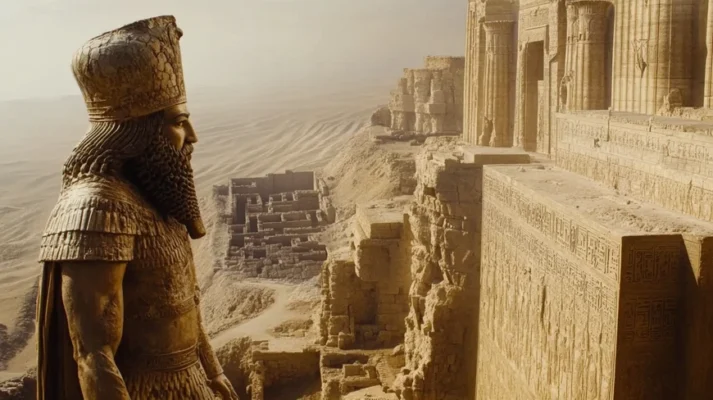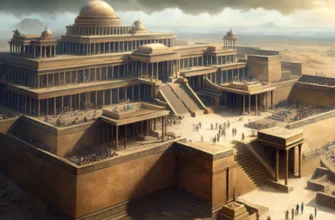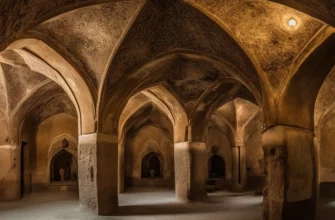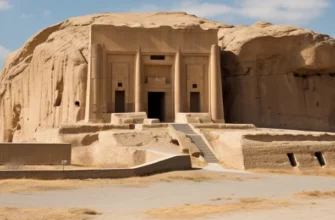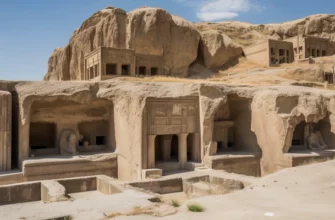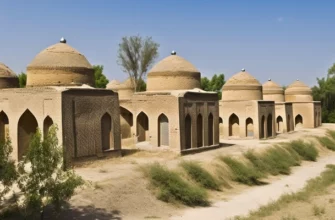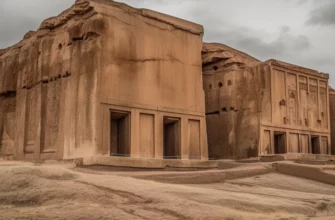Susa is one of the oldest cities in Iran, existing for over 4,000 years. It was an important cultural and political center located in modern-day Iran, near the Karun River in the historical region of Elam.
The city was founded during the Elamite period, and throughout its history, Susa became the capital of several great empires, including the Elamite and Persian empires. Susa played a key role in the economic and cultural development of the region.
Archaeological excavations have uncovered numerous temples, palaces, statues, and clay tablets containing important evidence of the religion, art, and social organization of the time. One of the most famous finds is the Code of Hammurabi, an ancient legal document kept in the Louvre, which testifies to the importance of Susa in the history of law.
The city remained important even after its conquest by Alexander the Great and its incorporation into the Seleucid Empire. Today, Susa is an important archaeological site, and its remains continue to be explored by scientists from around the world. Susa has also become a popular tourist destination, allowing people to better understand the richness and cultural heritage of ancient Iran.
History of Susa
Susa, one of the oldest cities in Iran, has a rich history spanning more than 4,000 years. The city was located in southwestern Iran, in the Karcheh River valley, and was the capital of several ancient civilizations, including Elam and Persia.
Elamite period (approximately 3rd millennium BC)
Susa was probably founded around 4000 BC as one of the centers of the Elamite civilization. It became an important commercial and cultural center where various peoples of the time interacted. Elamite culture developed in Susa over several centuries, and the city became one of the main political centers.
Akkadian period (approximately 23rd century BC)
In the 23rd century BC, Susa came under the rule of the Akkadian Empire under the leadership of Sargon the Great. Although the city suffered some destruction, its cultural and economic importance remained high.
Persian Empire (6th–4th centuries BC)
One of the most important stages in the history of Susa was its position within the Persian Empire. Cyrus the Great, founder of the Achaemenid dynasty, captured Susa in 539 BC, and the city became one of the main capitals of the Achaemenids.
During the reign of Darius I, a magnificent palace was built in Susa, which became an important symbol of the power of the Persian Empire.
The period after the conquest by Alexander the Great (4th century BC)
In 331 BC, Susa was captured by Alexander the Great. After that, the city came under the rule of the Seleucids and became an important part of their imperial structure. However, over time, Susa lost its former significance due to changes in the political situation.
Roman and Arab periods
In later periods, after the fall of the Seleucid Empire, Susa remained an important city at the crossroads of cultures, but its political and economic role declined. During the Arab conquests in the 7th century, Susa was largely destroyed, marking the beginning of its decline.
Today, Susa is an important archaeological site and part of the world’s cultural heritage. Archaeological excavations have uncovered many valuable artifacts that provide a better understanding of the city’s role in world history.
The birth and development of the city
Susa is one of the oldest cities in the world, founded around 4000 BC in what is now Iran, in the valley of the Karcheh River. Its development can be divided into several main stages.
Early settlements (approximately 4000–3000 BC)
The first settlements on the territory of Susa appeared as early as the Elamite period. These were small settlements mainly engaged in agriculture and cattle breeding. Thanks to its strategic location at the crossroads of trade routes, Susa began to actively develop as an important center for the exchange of goods, which contributed to its further growth.
The rise of the Elamite civilization (3000–1600 BC)
During this period, Susa became the main city of the Elamite civilization. It played the role of a political and economic center, and it was at this time that active construction of the city began.
The construction of temples, palaces, and fortifications demonstrated the growing importance of Susa. This period also saw the development of Elamite writing, which was used to record economic and administrative documents.
Interaction with other civilizations (1600–1200 BC)
Susa was located on an important trade route between Mesopotamia and the Indian subcontinent, which ensured its economic prosperity. During the reign of the Elamite kings, the city became one of the cultural and commercial centers, where there were constant contacts with other ancient civilizations, such as the Akkadian and Sumerian.
The period of the first conquests (1200–900 BC)
In the 12th century BC, Susa was attacked by neighbouring states, in particular the Assyrians. Although the city was captured and destroyed several times, its economy and cultural significance remained important, and the city was rebuilt after each attack.
Susa as part of the Persian Empire (600–400 BC)
During the reign of the Achaemenids, Susa became one of the main capitals of the Persian Empire. After its conquest by Cyrus the Great in 539 BC, the city became an important administrative and religious center.
During this period, magnificent palaces and temples were built in Susa, including the palace of Darius I, which became a symbol of the empire’s greatness.
Thus, Susa underwent several stages of development, from a simple settlement to a powerful city that became an important center of civilization in the Middle East. Its strategic location, economic power, and cultural significance left an important mark on history.
Archaeological evidence of early history.
Archaeological excavations in Susa allow us to reconstruct the early history of this city and understand its importance in the development of ancient civilizations. Thanks to numerous finds, scientists have been able to reconstruct life in Susa during the Elamite period, as well as during its heyday under the influence of other great empires.
Early settlement and first archaeological traces
The first archaeological evidence of settlements in the territory of Susa dates back to 4000 BC. During excavations, the remains of buildings were found, indicating the first settlements. These were small mud houses used for housing and domestic needs. During this period, agriculture and cattle breeding also began to develop.
The city during the Elamite period (3000–1600 BC)
During the Elamite period, when Susa became an important cultural and political center, archaeologists found many artifacts that testify to the high level of development of this city. Numerous cuneiform tablets containing administrative and economic records have been discovered. This helped scientists understand how trade was organized, what goods were exchanged, and how administrative activities were carried out.
One of the most significant archaeological evidence of Elamite culture is the remains of temples and palaces, among which the most famous is the temple dedicated to the god Inshushinak, one of the main gods of the Elamite religion. Statues, sacrificial altars, and religious artifacts found in temple complexes testify to the important role of religion in the life of society.
Archaeological finds of Elamite writing
Of particular importance are finds related to Elamite writing. Clay tablets and seals found in Susa contain notes relating to economic transactions and administrative acts. These tablets allow us to trace the development of Elamite writing, which is one of the oldest known writing systems in the Near East.
Architectural monuments
Archaeological excavations have uncovered the remains of large architectural structures such as palaces, temples, defensive walls, and gates, which testify to the high architectural skill of the inhabitants of Susa. For example, the palace built during the reign of Darius I in the 5th century BC is an important architectural monument. The enormous size and decorative decoration of the palace indicate the luxury and power of the Persian Empire.
Important archaeological finds: Code of Hammurabi
One of the most famous archaeological artifacts associated with Susa is the Code of Hammurabi. It is one of the first known legal systems, found on a stone tablet in Susa. The code contains laws and decrees governing various aspects of life in Mesopotamia, including property rights, justice, and punishment. This artifact is of great historical importance and provides insight into the organization of society at that time.
Goods and crafts
During the excavations, artifacts were also found that testify to the high level of development of crafts such as pottery, metallurgy, and textile production. Local craftsmen made objects from bronze, gold, and silver, and also painted ceramics, which is an important testimony to the high level of art and culture of that time.
Thanks to these archaeological finds, we have an idea of the early history of Susa, its role in the development of the Elamite civilization, and its importance as a major political, cultural, and economic center in the Middle East.
The city during the reign of great empires
Throughout its history, Susa has gone through several important periods when it was part of great empires, which had a significant impact on the development of the city. From the Elamite period to the Achaemenid period and later, Susa was a strategic and cultural center that played an important role in political and economic processes.
Elamite period (3000–1600 BC)
During its early development, Susa was the center of the Elamite civilization, which had a significant influence on the cultural and economic development of Mesopotamia. Susa was an important capital and administrative center for the Elamite rulers. Archaeological evidence shows that the city developed rapidly thanks to its strategic location at the crossroads of trade routes between Mesopotamia, India, and Persia. During this period, temples and palaces were built, and a writing system was developed, which later became the basis of Elamite writing.
The conquest of Susa by the Assyrians and Akkadians (around 2400 BC)
In the 24th century BC, Susa was conquered and subjugated by the Akkadian king Sargon the Great, who created one of the first empires in the Middle East. This conquest had a significant impact on the city, but Susa remained an important economic and political center and continued to develop even after the conquests. Later, the Assyrians also carried out several attacks on the city, and although Susa was destroyed, its strategic importance did not diminish.
Persian Empire (550–330 BC)
One of the most important periods for Susa was during the reign of the Achaemenids, when Susa became one of the main capitals of the Persian Empire. After the city was conquered by Cyrus the Great in 539 BC, Susa became part of the vast Achaemenid Empire, which led to a significant boom in the city.
Palace of Darius I
During the reign of Darius I, a huge palace was built in Susa, which became an important symbol of the power and greatness of the Achaemenids. Susa became not only a political but also an administrative center, as evidenced by numerous archaeological finds, including documents and royal decrees relating to the administration of the empire.
Role in the Persian administration
Susa became a repository for important state documents and a center for the dissemination of Persian culture, religion, and art. It was also an important religious center where gods from Persian mythology were worshipped and rituals were performed to maintain social order in the empire.
Susya during the conquest of Alexander the Great (331 BC)
In 331 BC, Susya was captured by Alexander the Great after his victory over the Persian king Darius III at the Battle of Gaugamela.
During Alexander’s conquests, the city was partially destroyed but retained its importance as a strategic center at the crossroads of trade routes.
After Alexander’s conquests
After Alexander’s death, Susa became part of the Seleucid Empire, a Greco-Bactrian kingdom that emerged from the ruins of the conquered Persian Empire. Susa lost its political independence, but its cultural and economic importance remained.
Later periods: Roman and Arab eras
During the period of the late conquests, Susa was again subjected to numerous attacks. It first fell under the control of the Roman Empire and later became part of the Muslim Caliphate after the Arab conquests in the 7th century. After the Arab conquest, Susa fell into significant decline, and although the city remained an important administrative center, it never regained its former glory.
Throughout the various periods of rule by great empires, Susa remained an important political, economic, and cultural center, playing a key role in the development of ancient civilizations in the Middle East. The city was conquered many times, but always remained an important strategic point due to its location and cultural heritage.
Important archaeological finds
As one of the oldest cities in the world, Susa has preserved a wealth of archaeological evidence that helps to reconstruct the history of this magnificent city and its role in the development of ancient civilizations.
Here are some key archaeological finds that are of great importance for understanding the early history of Susa:
Code of Hammurabi
One of the most famous archaeological finds is the Code of Hammurabi, an ancient legal document found in Susa. The code contains 282 laws that regulated various aspects of life in Mesopotamia, including property rights, punishment for crimes, and principles of justice. It was written on a stone tablet in 1754 BC during the reign of the Babylonian king Hammurabi. Found in Susa, this stele is an important testimony to the legal system of the time and is one of the greatest achievements of ancient law.
Palace of Darius I
The Palace of Darius I in Susa, built in the 5th century BC, is a huge architectural monument reflecting the grandeur and power of the Achaemenids. The ruins of the palace, including numerous walls, gates, columns, and other architectural elements, give an idea of the luxury and grandeur of the Persian Empire. The remains of the palace also contain reliefs and bas-reliefs depicting scenes from festivals and ceremonies that took place at the court of the Persian rulers.
Clay tablets with writing
A large number of clay tablets containing text in Elamite script were found in Susa. This is an important archaeological find, as Elamite writing is one of the oldest known writing systems. The tablets often contain economic records, administrative documents, and religious texts. They help scientists understand how trade was organized, how the Elamite period was governed, and what religious practices existed.
Gold and silver objects
Susa was famous for its crafts, particularly the production of gold and silver jewelry. Archaeologists have discovered numerous gold and silver ornaments, including necklaces, intricately crafted amulets, tableware, and other objects that were used in rituals and as symbols of power.
These finds are evidence of the high level of craftsmanship and the grandeur of the city during its heyday.
Statues and reliefs
Numerous statues have been found in Susa, including statues of Elamite gods and kings. One of the important finds are statues depicting the religious cults of the Elamites. Reliefs found in temple complexes and palaces depict scenes of religious rituals, such as sacrifices, indicating a strong religious influence on the political life of the city.
Seals and signs
Seals and other marks with Elamite inscriptions have been found, helping scientists understand the administrative activities in Susa. Seals were used to mark documents, goods, and objects, confirming the development of trade and administrative relations. Such finds are invaluable for studying the economic and political organization of the city.
Pottery and household items
Archaeologists have also found a large number of ceramic items, indicating the development of crafts in Susa. The clay pots, dishes, amphorae, and tiles with various patterns and ornaments help us understand the daily life of the city’s ancient inhabitants, their cultural preferences, and aesthetic standards.
Goods and valuables
Items confirming active trade with other cultures were also found in Susa. These included precious stones, spices, skins, and fabrics, indicating Susa’s economic role in world trade at that time.
The archaeological finds of Susa are not only important artifacts that give us knowledge about the culture, economy, and religion of ancient civilizations, but also documents that allow us to gain a deeper understanding of the political history and administrative organization of ancient Iran. Excavations in Susa continue to reveal new aspects of the history of this great city, which played a key role in the history of the Middle East.
Culture and art
Susa, as one of the most important cities of ancient Iran, was not only a political and economic center, but also an important cultural center. A unique Elamite culture developed here, which had a profound influence on architecture, art, literature, and religion. The culture of Susa was multifaceted and included elements of both Elamite and later influences from Persian, Babylonian, and other civilizations.
Architecture and construction
The architecture of Susa was notable for its grandeur and diversity, which has been preserved to this day thanks to archaeological excavations. The city was located on a large territory, and many of its architectural structures testify to the high level of skill of the builders.
Temples and religious buildings
One of the important aspects of architecture were temples dedicated to the Elamite gods. The most famous of these is the temple of Inshushinak, the god of the city and one of the main gods of the Elamite religion. The temples in Susa were usually large, with luxurious reliefs and bas-reliefs depicting scenes of religious rituals and sacrificial ceremonies.
Achaemenid palaces
During the Persian Empire, under the reign of Darius I and other Persian kings, huge palaces were built in Susa. The grandeur and luxury of these palaces testify to the high skill of the architects and artists of that time. The palace of Darius I, built in the 5th century BC, is one of the finest examples of Achaemenid architecture. The luxurious walls, columns, and painted ceilings and floors were striking in their beauty.
Art and sculpture
The art of Susa developed over several centuries, and its main manifestations were reliefs, statues, and decorative art.
Reliefs and bas-reliefs
Reliefs depicting scenes from religious ceremonies, military victories, and everyday life are an important element of Suse art. They can be found on the walls of temples, palaces, and various public buildings. For example, the walls of Darius I’s palace depict numerous scenes from his reign, including sacrifices and ceremonies honoring the gods.
Statues of kings and gods
Special attention should be paid to statues depicting not only gods but also rulers. One of the most famous statues is that of King Shutruk, an important symbol of Elamite art. Statues of Inshushinak and other deities were also found in Susa, reflecting the religious beliefs of the city’s inhabitants.
Ceramics and decorative arts
Ceramics in Susa were an important part of everyday life, as well as an element of decorative art. Ceramic products were noted for their high quality and often featured intricate ornamentation. In addition, many ceramic items, such as pots, dishes, and vases, were decorated with patterns that had religious or cultural significance.
Decorative arts also included metallurgy—the production of gold, silver, and bronze jewelry and amulets. Archaeological finds show that the craftsmen of Susa produced not only jewelry but also ritual objects used in temples and during religious ceremonies.
Literature and writing
Writing in Susa developed on the basis of Elamite writing, which was of great importance for recording administrative documents, trade agreements, and religious texts.
Clay tablets with cuneiform writing are among the most important archaeological finds that help us understand how the administration was organized in Susa and what social structures existed in the city.
Literary works written in the Elamite or Sumerian languages were also an important element of Susa’s culture. They often contained myths, religious texts, and even poems praising the royal power and divine forces.
Religious art
The religious art of Susa reflected the important role of religion in the life of this city. Most of the archaeological finds with religious motifs have a sacred meaning. These include both statues of deities and religious reliefs depicting scenes from rituals and worship.
The god Inshushinak, one of the main gods of the Elamite religion, was often depicted on stone slabs and statues. This testifies to the importance of religious cults and ceremonies for the social and cultural organization of society.
The culture and art of Susa developed under the influence of various civilizations but had their own unique characteristics. Magnificent architectural structures, impressive statues, reliefs, and decorative items, as well as the development of writing and literature, allow us to see how the city became an important cultural center in the Middle East. The art of Susa not only reflects the beauty and skill of its creators, but also provides a deep understanding of the spiritual and cultural life of the ancient Iranians.
Famous artifacts
Thanks to its rich historical past, Susa is home to numerous archaeological finds that are of great importance for the study of ancient civilizations in the Middle East. Many of the artifacts found in Susa are among the most important monuments of human history.
Here are some of the most famous artifacts that have become symbols of the city’s cultural heritage:
Code of Hammurabi
One of the most famous artifacts found in Susa is the Code of Hammurabi, one of the oldest and most important legal documents in human history. It was discovered in 1901 and is a stone stele containing 282 laws formulated by the Babylonian king Hammurabi in 1754 BC. The code describes the laws governing property relations, punishment for crimes, and many other aspects of social life. The discovery of this artifact in Susa is evidence that the city was an important administrative and political center even after the fall of the Babylonian Empire.
Stele of Darius I
The Stele of Darius I, dating from the 5th century BC, is an important artifact from the reign of Darius I, king of the Achaemenids. This stele contains an inscription explaining Darius’ conquests and his policies for organizing the empire. It was found in Susa and is an important testimony to the administrative and political processes in the Achaemenid Empire. The stele also contains an image of King Darius himself, giving us an idea of what Persian rulers looked like.
Golden rhyton (Persian cup)
The famous golden rhyton is an object that was used in religious and royal ceremonies. This elegantly crafted golden cup decorated with lions was found in Susa and is an important example of Persian jewelry craftsmanship. Rhytons were used during ritual sacrifices or in royal ceremonies, emphasizing the importance of these objects in Persian culture and religion.
Statues of the god Inshushinak
Statues of the god Inshushinak, the chief god of Susa, have been found in several locations within the ancient city. Inshushinak was a deity of fertility, war, and power, and his cult was of great importance in the religious life of Susa. The statues, which often depict the god in human form, are important artifacts that help us understand the Elamite religion and beliefs of the time.
Stele with the inscription of Shutruha (king of the Elamite dynasty)
Found in Susa, the Shutruha stele is an important document that recounts the history of this Elamite king’s reign. The inscription on the stele provides insight into many aspects of the political and social organization of the Elamite state, as well as the nature of its interactions with other peoples of the time, such as the Babylonians and Assyrians. This artifact is also of great importance for the study of Elamite writing and its evolution.
Statue of King Shutruha
The statue of King Shutruha, found in Susa, is one of the iconic artifacts of Elamite culture. This statue depicts one of the rulers of the Elamite dynasty in traditional royal attire and is an important example of Elamite sculpture. Statues similar to this one were used not only as works of art but also as religious objects of worship.
Clay tablets with cuneiform writing
Numerous clay tablets with cuneiform inscriptions containing administrative, economic, and legal documents have been found in Susa. These tablets help scholars reconstruct the system of government in the Elamite civilization and also testify to the development of writing in this region. Some tablets even contain records of trade agreements and contracts.
Gold jewelry and amulets
Susa is known for its skill in working with gold and silver.
Among the artifacts found are numerous gold jewelry, amulets, and other precious items. These items are not only evidence of a high level of craftsmanship, but also had important religious significance, as many of them were used in rituals or were part of royal gifts.
Persian bronze objects
Persian bronze vessels, jewelry, precious objects, and religious artifacts are another important category of finds from Susa. They reflect the high level of technology and art characteristic of Persian civilization. Bronze objects were often made for royal court ceremonies or religious rites.
Bowls and vessels with Elamite ornamentation
Decorative bowls and vessels with Elamite ornamentation are also important artifacts that demonstrate the high level of decorative art of the Elamites. These objects often featured intricate designs depicting scenes from religious life or nature.
The famous artifacts found in Susa allow us to delve deeper into the history, culture, and art of this ancient city. They testify to the grandeur of Susa, its strategic importance, and its cultural heritage, which had a significant impact on the development of civilizations in the Middle East.
The role of Susa in world history
Susa, one of the oldest and most famous cities of ancient Iran, played a key role in the development of world history for several millennia.
Located in the heart of Elam, it became an important political, economic, cultural, and religious center in the Middle East. Susa not only witnessed tremendous historical events but also actively contributed to the formation of civilizational processes in the region, significantly influencing the development of other cultures and empires.
Political center and capital of the Elamite kings
Susa was one of the main capitals of the Elamite Empire, which existed from the 3rd millennium BC to the middle of the 6th century BC. This city became the center of Elamite culture and politics, where royal palaces and important state institutions were located. Susa was also the main religious center of Elam, where gods were worshipped, in particular the god Inshushinak.
Over time, Susa became an important political arena where the interests of numerous empires, including the Babylonians, Assyrians, and Persians, intersected. During the Achaemenid Empire, after the conquest of Elam by Darius I, Susa became one of the main capitals of the Persian Empire, emphasizing its strategic importance on the political map of the ancient world.
Role in the development of writing and the legal system
Susa became an important center for the development of ancient writing and legal systems. In addition to the traditional Elamite script, which was used for administrative purposes, the famous Code of Hammurabi, one of the oldest written documents on earth, was found in Susa. This testifies to the great influence of Susa in the development of law, which became the basis for later legal traditions.
In addition, archaeological finds such as clay tablets with cuneiform writing help us understand the system of governance and documentation used in Susa, which reflected a high level of organization and bureaucracy.
Economic center of trade and crafts
Susa played an important role in trade between Mesopotamia, India, Central Asia, and other parts of the ancient world. The city was a crossroads for numerous trade routes and a major economic center, which contributed to the development of crafts such as metallurgy, ceramics, textiles, and jewelry making.
Trade links with other civilizations provided Susa with a wealth of exotic goods and opportunities for the development of high-level art, reflecting the economic power of the city.
Cultural and religious center
Susa became the center of Elamite culture, which had a significant influence on neighboring civilizations. The art, architecture, religious practices, and literature of Susa greatly influenced the development of neighboring cultures, particularly those of Babylonia and Persia. Religious beliefs and practices associated with the worship of the gods of the Elamite religion penetrated other cultural traditions, testifying to the importance of Susa in the spiritual life of the region.
The religious art of Susa is particularly important, as it reflected the religious beliefs of the time. Large statues, reliefs, and temple complexes became symbols of Elamite religious culture and played an important role in shaping religious beliefs in other civilizations.
Influence on political processes and empires
The conquest of Susa by the Persians during the reign of Darius I was an important milestone in the history of this city. The victory of the Persians over the Elamites allowed the creation of a powerful Persian Empire, and Susa became one of the main centers of Persian administration. This testifies to the strategic importance of Susa in the formation of one of the largest and most powerful states of the ancient world.
Already during the reign of the Achaemenids, Susa became an important political and cultural center. The palace of Darius I in Susa is one of the great architectural achievements of this period, emphasizing the city’s role in reflecting the grandeur of the Persian Empire.
The legacy of Susa in world culture
Susa left a huge legacy that encompasses not only architecture and art, but also legal and administrative practices that had a lasting impact on subsequent civilizations. The Code of Hammurabi became the basis for the development of jurisprudence in many countries, and the architectural styles of Susa became a model for construction in other parts of the Persian Empire.
The city also had a major influence on the development of writing, law, crafts, and science, which became an important part of humanity’s cultural heritage.
Susa played a key role in the development of world history, particularly through its strategic location, political significance, economic role, and cultural heritage. From the Elamite era to the Achaemenid period, the city was an important center in the Middle East, contributing to the development of religion, art, science, and law. Susa’s role in world history is extremely important, and its legacy continues to influence our understanding of ancient civilizations.
The current state and research of Susa
With its rich history and archaeological heritage, Susa remains an important subject of study for historians, archaeologists, and cultural scholars. The current state of Susa in the context of archaeological research and heritage preservation is complex, as the city has undergone numerous destructions over the centuries. However, thanks to modern efforts to protect and study archaeological sites, Susa continues to reveal new pages of ancient Iranian history.
Archaeological research and excavations
Archaeological research in Susa has been going on for over a century, starting in the late 19th century, when the first major excavations were carried out by French archaeologists led by Jacques de Morgan. Since then, Susa has become one of the most researched archaeological sites in the Middle East.
In 1901, the famous Code of Hammurabi was found, which became one of the most important archaeological finds of all time.
Modern excavations in Susa have been ongoing since the 1950s and continue to this day. They are carried out by both local and international archaeological teams, often using the latest technologies such as ground-penetrating radar, aerial photography drones, and radiocarbon dating methods.
Protection of cultural heritage sites
The preservation and protection of Susa’s archaeological sites is one of the main challenges facing modern research. The city and its archaeological monuments have suffered significant damage during numerous historical events, particularly as a result of military conflicts and natural disasters. This has led to the partial loss of some unique artifacts and the destruction of individual buildings.
The protection of sites such as the Palace of Darius I, the Hammurabi Stele, and religious complexes, which are extremely vulnerable, is particularly important. Conservation issues are also linked to urban development and construction on archaeological sites.
International organizations such as UNESCO actively support the protection of Susa’s cultural heritage, particularly through programs for the preservation and restoration of ancient monuments, but these efforts may be complicated by political and economic problems in Iran.
Contemporary research and new discoveries
One of the important features of contemporary archaeological research is the use of the latest technologies, which allow new layers of Susa’s history to be uncovered that previously remained unnoticed. For example, the use of radiocarbon dating and ground-penetrating radar helps to determine the age of various artifacts and buildings, as well as to explore not only the surface but also the deeper layers of the ancient city.
Recently, new artifacts such as pottery, statuettes, and clay tablets have been discovered in Susa, adding new facts to our understanding of the social, economic, and political organization of the Elamite civilization. In addition, researchers are focusing on studying architectural remains and religious objects, such as temples and images of deities, which help reconstruct the religious practices of ancient Iran.
Tourism and cultural significance
As an important cultural site, Susa attracts not only archaeologists but also tourists.
The city is located in modern-day Iran, where interest in the cultural heritage of Susa remains high. Tourism plays an important role in supporting research and infrastructure development, but at the same time, it poses certain risks to the preservation of monuments, as the flow of tourists can lead to additional wear and tear on historical sites.
Research prospects and challenges
Despite numerous achievements in archaeological research in Susa, there are still many unexplored areas that require attention.
In particular, the filled layers of the city need to be explored, as they may contain new artifacts and information about life in Susa at different stages of history. It is especially important to preserve sites associated with periods when the city was under the rule of different empires, as these stages can provide new insights into the political and cultural processes of the time.
One of the main challenges for modern researchers is to ensure the sustainable protection of monuments and their preservation for future generations, despite political and economic difficulties. In addition, the support of the international community is needed to conduct research and preserve Susa as one of the world’s largest archaeological sites.
The current state of Susa is a combination of great archaeological achievements and serious challenges to the protection of cultural heritage. The city continues to reveal new secrets of its history thanks to modern technology and the efforts of the international archaeological community. However, in order to prevent this heritage from being lost, it is important to maintain a balance between research, preservation of monuments, and the development of tourism.
Conclusions
Susa, one of the greatest archaeological and cultural treasures of Ancient Iran, occupies an important place in human history. Its multifaceted role in the development of civilizations, from the Elamite era to the reign of the Achaemenids, has left an enduring legacy that continues to influence modern science.
Archaeological significance of Susa: Thanks to extensive archaeological research conducted in Susa, scientists are able to reconstruct important stages in the development of the ancient city, from political structures to religious and cultural practices. The discovery of important artifacts such as the Code of Hammurabi only emphasizes the importance of Susa in world history.
Preservation of cultural heritage: Preserving the monuments of Susa is a major challenge due to destruction and natural disasters. However, modern archaeological efforts and international initiatives are contributing to the protection and restoration of this historic center.
Impact on neighboring cultures: Susa was an important cultural, political, and commercial center that had a huge influence on neighboring civilizations, particularly Babylon, Assyria, and Persia, creating conditions for cultural exchange and development.
Current status and future prospects: Modern research and the latest technologies are making it possible to discover new aspects of Susa’s ancient history. However, further study and preservation efforts are needed, particularly in the areas of monument protection and the development of tourism infrastructure.
Overall, Susa is not only an important part of Iranian history, but also of world history. Its significance as a historical, cultural, and archaeological center continues to grow, and the study of this ancient city provides a deeper understanding of the development of human civilizations in the Middle East.
